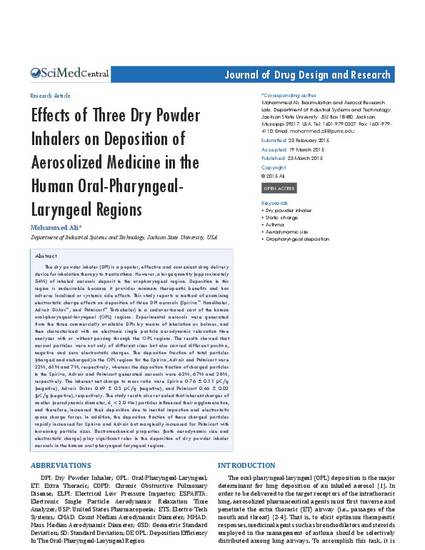
Article
Effects of Three Dry Powder Inhalers on Deposition of Aerosolized Medicine in the Human Oral-Pharyngeal-Laryngeal Regions
Technology Faculty Publications and Presentations
Abstract
The dry powder inhaler (DPI) is a popular, effective and convenient drug delivery device for inhalation therapy to treat asthma. However, a large quantity (approximately 54%) of inhaled aerosols deposit in the oropharyngeal region. Deposition in this region is undesirable because it provides minimum therapeutic benefits and has adverse localized or systemic side effects. This study reports a method of examining electrostatic charge effects on deposition of three DPI aerosols (Spiriva™ Handihaler, Advair Diskus™, and Pulmicort™ Turbohaler) in a cadaver-based cast of the human oral-pharyngeal-laryngeal (OPL) regions. Experimental aerosols were generated from the three commercially available DPIs by means of inhalation as boluses, and then characterized with an electronic single particle aerodynamic relaxation time analyzer with or without passing through the OPL regions. The results showed that aerosol particles were not only of different sizes but also carried different positive, negative and zero electrostatic charges. The deposition fraction of total particles (charged and uncharged) in the OPL regions for the Spiriva, Advair and Pulmicort were 22%, 61% and 7%, respectively, whereas the deposition fraction of charged particles in the Spiriva, Advair and Pulmicort generated aerosols were 62%, 67% and 28%, respectively. The inherent net charge to mass ratio were Spiriva 0.76 ± 0.11 µC/g (negative), Advair Diskus 0.49 ± 0.3 µC/g (negative), and Pulmicort 0.46 ± 0.02 (µC/g (negative), respectively. The study results also revealed that inherent charges of smaller (aerodynamic diameter, da < 2.0 µm) particles influenced their agglomeration, and therefore, increased their deposition due to inertial impaction and electrostatic space charge forces. In addition, the deposition fraction of these charged particles rapidly increased for Spiriva and Advair but marginally increased for Pulmicort with increasing particle sizes. Electromechanical properties (both aerodynamic size and electrostatic charge) play significant roles in the deposition of dry powder inhaler aerosols in the human oral-pharyngeal-laryngeal regions.
Publisher
Journal of Drug Design and Research - SciMedCentral
Date of publication
2-1-2015
Language
English
Persistent identifier
http://hdl.handle.net/10950/1871
Document Type
Article
Subject Categories
Publisher Citation
Ali M (2015) Effects of Three Dry Powder Inhalers on Deposition of Aerosolized Medicine in the Human Oral-Pharyngeal-Laryngeal Regions. J Drug Des Res 2(1): 1009.
Citation Information
Ali M (2015) Effects of Three Dry Powder Inhalers on Deposition of Aerosolized Medicine in the Human Oral-Pharyngeal-Laryngeal Regions. J Drug Des Res 2(1): 1009.
